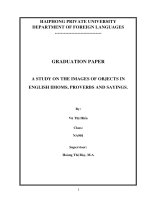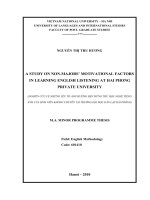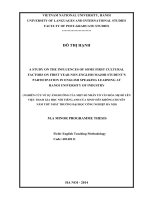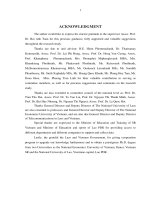A study on the teacher’s roles in group work in communicative language teaching at phuc tho high school, hanoi
Bạn đang xem bản rút gọn của tài liệu. Xem và tải ngay bản đầy đủ của tài liệu tại đây (279.93 KB, 11 trang )
VIETNAM NATIONAL UNIVERSITY, HA NOI
UNIVERSITY OF LANGUAGES AND INTERNATIONAL STUDIES
FACULTY OF POST-GRADUATE STUDIES
------
NGUYỄN THỊ THU HUYỀN
A STUDY ON THE TEACHER’S ROLES IN GROUP WORK
IN COMMUNICATIVE LANGUAGE TEACHING
AT PHUC THO HIGH SCHOOL,HANOI
(Nghiên cứu vai trò của giáo viên trong hoạt động nhóm
ở lớp học giao tiếp ở trường THPT Phúc Thọ, Hà Nội )
M.A. MINOR PROGRAMME THESIS
Field: English Teaching Methodology
Code: 60140111
Hanoi - 2016
VIETNAM NATIONAL UNIVERSITY, HA NOI
UNIVERSITY OF LANGUAGES AND INTERNATIONAL STUDIES
FACULTY OF POST-GRADUATE STUDIES
------
NGUYỄN THỊ THU HUYỀN
A STUDY ON THE TEACHER’S ROLES IN GROUP WORK
IN COMMUNICATIVE LANGUAGE TEACHING
AT PHUC THO HIGH SCHOOL, HANOI
(Nghiên cứu vai trò của giáo viên trong hoạt động nhóm
ở lớp học giao tiếp ở trường THPT Phúc Thọ, Hà Nội )
M.A. MINOR PROGRAMME THESIS
Field: English Teaching Methodology
Code: 60140111
Supervisor: Assoc.Prof. Dr. Nguyễn Xuân Thơm
Hanoi - 2016
DECLARATION
I, Nguyen Thi Thu Huyen, declare that this thesis is my own research for the
Degree of Master of Arts at the University of Languages and International Studies,
Vietnam National University, Hanoi and that this thesis has not been submitted for
any degree at any other university or institution.
Hanoi,2016
Nguyễn Thi Thu
Huyề n
̣
i
ACKNOWLEDGMENTS
First and foremost, I would like to express special thanks to my supervisor
Assoc.Pro.Dr. Nguyễn Xuân Thơm for revising my thesis, for his valuable advice,
kind and helpful attitude and considerable assistance that he provided me
throughout the study.
I am also greatly indebted to all the lecturers at the Faculty of PostGraduate Studies, University of Languages and International Studies, Vietnam
National University, Hanoi, for their useful lectures which played an important role
in the completion of my thesis.
Finally, I wish to thank all my friends and colleagues for their support during
the process of writing this paper.
ii
ABSTRACT
One of the techniques of communicative language teaching is group work,
which provides a chance for social interaction. Group work is one of the possible
solutions of the problem how to get all students to speak in language lessons. The
teachers sometimes have a tendency to interrupt students when they are speaking
together during group work activity. The students do not feel comfortable with the
interventions. This research was carried out to investigate the roles of teacher and
the behaviors of the tenth-grade students to these roles in group work activities in
communicative language teaching at Phuc Tho high school, Hanoi.
The data for this research was collected through the observation of some
communicative classes in grade 10 and in the forms of survey questionnaire for the
tenth-grade students at Phuc Tho high schoool. The findings of the research
revealed that the teacher plays most roles in all stages of group work, the students
like to work with their friends, arranging weak students and strong students into
groups is very helpful, most of the students want to practise speaking English in class
without the teacher’s control, the teacher needs to be sensitive when interrupting group
work communication and the teacher should always available and only interrupt
students’ work when they ask for support.
It is hoped that this thesis will help other teachers of English to make use of
their roles appropriately in group work activities, to help students learn best in
groups and to take all advantages of the group work under their arrangement.
iii
iv
PART A: INTRODUCTION
1. Rationale
As far as we know, in recent years there have been number of exciting
developments in language teaching. These developments are sometimes referred to
as communicative language teaching (CLT). According to Nolasco and Arthur
(1988) a greater emphasis on activities in which students have chance to determine
what they want to say independently on the teacher is among the most important
features of CLT. The problem of getting students to express themselves freely in the
foreign language has come to prominence.
One of the techniques of communicative language teaching is group work, which
provides a chance for social interaction. Group work is a class management strategy
and the role of the teacher has to play while teaching is of a facilitator. Teacher’s
role in group work is very difficult and at the same time it is very important role,
too. Groups of some students can be formed to solve a problem or pose a question.
The teacher can organize these groups at any time in a class of any size to check on
the students’ understanding of the material, to give students an opportunity to apply
what they are learning, or to provide a change of pace.
I have chosen the topic of group work for my thesis since it is one of the possible
solutions of the problem how to get all students to speak in language lessons. I often
use this way of interaction in my teaching, but I sometimes have a tendency to
interrupt students when they are speaking together during group work activity. I
have noticed that they do not feel comfortable with my interventions. That is why I
decide to observe students’ behavior to find out how this is changing with various
teacher’s roles. My main aim is to find out what teachers actually do in various
stages of group work and what are students’ perception and reactions to teacher’s
roles. I will observe my own classroom to examine how many roles the teacher has
during one stage of an activity.
2. Aims of the study
The purpose of this research is to find out the roles of teacher in group work
activities in class and students’ behaviors to the teacher’s roles in order to obtain
1
valid information regarding the effective use of group work under teacher’s
management, so as to bring innovation in class. The focus is on group work in
English language classes.
The specific purpose of the study was to:
-
evaluate
the
different
roles
of
teacher
in
group
work
activities.
- find out the behaviors of the students towards the teacher’s roles in some group
work activities.
3. Significance of the study
The findings of the study would be much beneficial to teachers of English who are
considering how to make use of their roles appropriately in group work activities,
how to help students learn best in groups and how to take all advantages of the
group work under their arrangement.
4. Research questions
The study aims to answer the following research questions:
(i) What are the roles of teacher in group work in grade 10 at Phuc Tho
high school?
(ii) What are behaviors of 10th grade students at PhucTho high school
toward the teacher’s roles in implementing group work activities?
5. Method of the study
In order to achieve the purpose of the study, both qualitative and quantitative
methods will be used. Class observation will be carried out with the detailed notes
about students’ behaviors about the teacher’ roles during the process of
implementing six group work activities. In addition, a survey questionnaire will be
delivered to get result from 120 students who are chosen randomly from the tenthgrade classes at Phuc Tho high school. All comments, remarks, recommendations
and conclusion will be carefully considered based on the data analysis.
6. Scope of the study
The study is designed to find out the roles of teacher and the tenth-grade students'
behaviors about the roles of teacher in group work in communicative language
2
REFERENCES
1. Alandeom, O., & Sadler, T. (2008). Interactive patterns and conceptual
convergence during student collaborations in science. Journal of Research in
Science Teaching, 26, 634–658.
2. Baines, E., Blatchford, P. and Kutnick, P. (2003) Changes in grouping
practices in primary and secondary school. International Journal of
Educational Research, 39, 9–34.
3. Bertrand, J. (2006). Working in Pairs and Groups. Bristish Council.
4. Bennett, N., & Dunne, E. (1992). Managing classroom groups. Hemel
Hempstead: Simon & Schuster Education.
5. Bennett, J., Lubben, F., & Campbell, B. (2004). A systematic review of the
use of small-group discussions in science teaching with students aged 11–18,
and their effects on students’ understanding in science or attitude to science:
Review summary. York: University of York.
6. Brookfield, S.D., &Preskill, S. (1999). Discussion as a Way of Teaching:
Tools and Techniques for Democratic Classrooms. San Francisco: JosseyBass Publishers
7. Doff,A.(1988). Teach English – A train course for teachers. Cambridge
University Press in association with The Bristish Council.
8. Galton, M., & Williamson, J. (1992). Group work in the primary classroom.
London: Routledge.
9. Gillies, R. M., & Boyle, M. (2010). Teachers’ reflection on cooperative learning:
Issues of implementing. Teaching and Teacher Education, 26, 933–940.
10. Griffiths, B. (2005) Teacher Positioning in the Classroom. Teaching English.
Brishtish Council.
11. Hammer, J. (1991). The Practice of English Language Teaching New York:
Longman Publishing.
12. Harmer J. (1999), Practice of ELT, Longman.
3
13. Honey J. 91991), The Formation of Small Groups in the Language
Classroom, Guidelines – A periodical for Classroom Language teachers,
Vol. 113 No. 1 June 1991, Semeo Regional Language Centre.
14. Hymes, D. (1972). On Communicative Competence. Harmondsworth: penguin
15. Jaques, D. (2000). Learning in Groups: A Handbook for Improving Group
Work, 3rd ed. London: Kogan Page.
16. Little, W. (1981). Communicative Language Teaching: An Introduction,
Cambridge: CUP.
17. Lumpe, A.T., & Haney, J.J. (1998). Science teachers’ beliefs and intentions
regarding
the
use
of
cooperative
learning.
School
Science
and
Mathematics,3, 123–135.
18. Nolasco, R. (1988), Lois, A. Large Classes. Mackmillan Publishers.
19. Nolasco, R. and Athur, L. (1993). Large Classes. London: Macmillan.
20. Nunan D. (1989), Desining Tasks for the Communicative Classroom,
Cambridge University Press.
21. Nunan, D. (1991). Language Teaching Methodology, London: Prentice Halls.
22. Nunan, D., & Lamb, C. (1996). The self-directed teacher: Managing the learning
process. Cambridge, Cambridge University Press.
23. Race, P. (2000). 500 Tips on Group Learning. London: Kogan Page.
24. Richards J. C.
and Rodgers T. S. (1986), Approaches to Methods in
Language Teaching, Cambridge University Press.
25. Richard, C. and Rodges, T. S. 2001. Approaches and Methods in Language
Teaching. Cambridge: CUP.
26. Springer, L., Stanne, M. E., & Donovan, S. S. (1999). Effects of small-group
learning on undergraduates in science, mathematics, engineering and
technology: A meta-analysis.Review of Educational Research, 69, 21–51.
27. Wright, T. (1987) Roles of Teachers and Learners. Oxford University Press.
28. />
4
I


![gherghina et al - 2014 - a study on the relationship between cgr and company value - empirical evidence for s&p [cgs-iss]](https://media.store123doc.com/images/document/2015_01/02/medium_JKXoRwVO1T.jpg)






